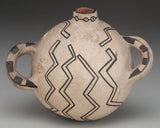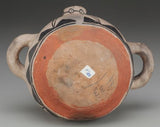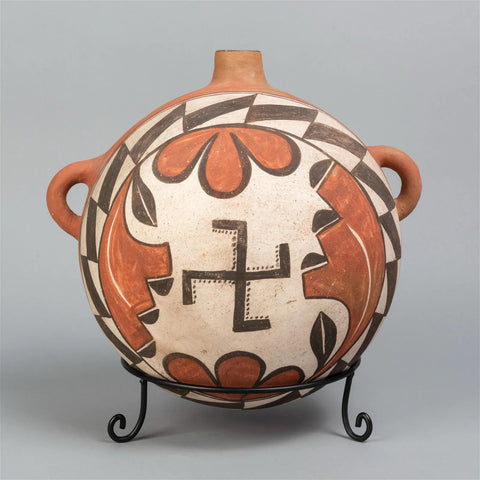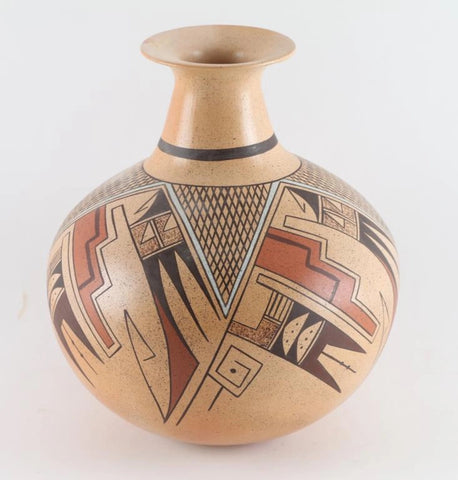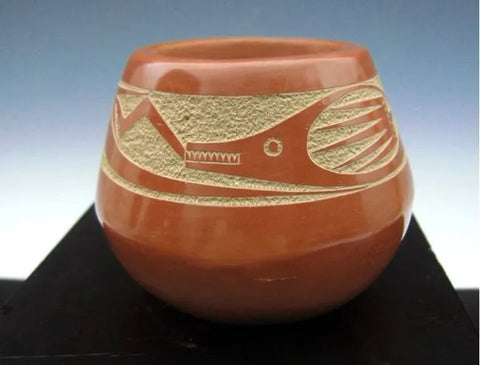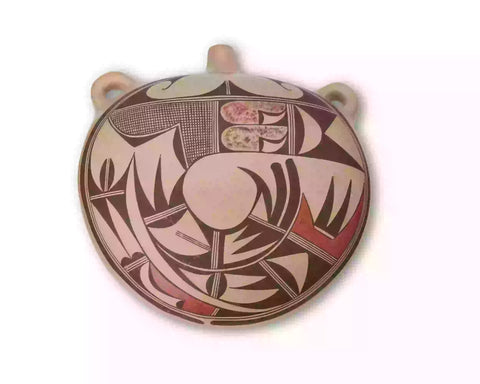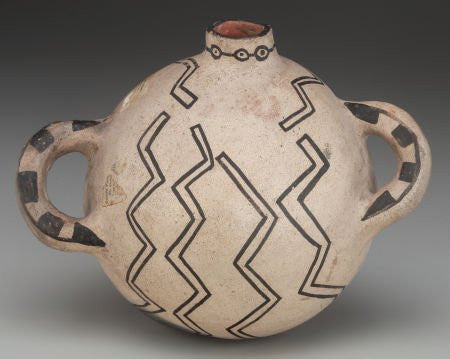
A Native American Historic Cochiti Polychrome Canteen, c. 1900, #797
$ 3,561.00
A Native American
Cochiti Polychrome Canteen, c. 1900
797. Description: A Native American Historic COCHITI POLY CHROME CANTEEN c. 1900,
Condition: Very good for its age. Clay, paint, with old tag attached,
Dimensions: 8 inches X 5 inches.
Provenance: From the Valentine Pasvolsky Collection, inscribed From Cochiti Pueblo Indians, Rio Grande River, New Mexico
---------
While serving in the U.S. army, Valentine Pasvolsky was afforded the opportunity to travel. In his off-hours, he visited numerous American Indian tribes and became a trusted friend. Through visits and trade with the natives, he continually expanded his knowledge of native life as well as his collection of artifacts, eventually amassing one of the largest private collections of North and South American Indian art in the world.
Pasvolsky began exhibiting his collection at his home, known as the Indian Village Museum and Trading Post of Lakewood in New Jersey. Three rooms on the first floor served as a museum, open to the public for a nominal fee. School children, scouts and other interested individuals spent hours studying his displays.
Pasvolsky, in turn, thoroughly enjoyed sharing his vast knowledge with his patrons. To boot, he began exhibiting select items from his collection at various events, often giving presentations donned in full Indian regalia.
Pasvolsky's collection of North and South American Indian art was divided between his son and daughter. For the second time, Heritage represented the Valentine Pasvolsky Collection. The present sale represented his son's inheritance; the daughter's family sold their portion of the collection through Heritage in November of 2013 and May of 2014.
--------
A History of Pueblo Pottery:
“Pueblo pottery is made using a coiled technique that came into northern Arizona and New Mexico from the south, some 1500 years ago. In the four-corners region of the US, nineteen pueblos and villages have historically produced pottery. Although each of these pueblos use similar traditional methods of coiling, shaping, finishing and firing, the pottery from each is distinctive.
Various clay's gathered from each pueblo’s local sources produce pottery colors that range from buff to earthy yellows, oranges, and reds, as well as black. Fired pots are sometimes left plain and other times decorated—most frequently with paint and occasionally with appliqué. Painted designs vary from pueblo to pueblo, yet share an ancient iconography based on abstract representations of clouds, rain, feathers, birds, plants, animals and other natural world features.
Tempering materials and paints, also from natural sources, contribute further to the distinctiveness of each pueblo’s pottery. Some paints are derived from plants, others from minerals. Before firing, potters in some pueblos apply a light colored slip to their pottery, which creates a bright background for painted designs or simply a lighter color plain ware vessel. Designs are painted on before firing, traditionally with a brush fashioned from yucca fiber.
Different combinations of paint color, clay color, and slips are characteristic of different pueblos. Among them are black on cream, black on buff, black on red, dark brown and dark red on white (as found in Zuni pottery), matte red on red, and polychrome—a number of natural colors on one vessel (most typically associated with Hopi). Pueblo potters also produce un-decorated polished black ware, black on black ware, and carved red and carved black wares.
Making pueblo pottery is a time-consuming effort that includes gathering and preparing the clay, building and shaping the coiled pot, gathering plants to make the colored dyes, constructing yucca brushes, and, often, making a clay slip. While some Pueblo artists fire in kilns, most still fire in the traditional way in an outside fire pit, covering their vessels with large potsherds and dried sheep dung. Pottery is left to bake for many hours, producing a high-fired result.
Today, Pueblo potters continue to honor this centuries-old tradition of hand-coiled pottery production, yet value the need for contemporary artistic expression as well. They continue to improve their style, methods and designs, often combining traditional and contemporary techniques to create striking new works of art.” (Source: Museum of Northern Arizona)
----------
View the other items in my shop: http://www.etsy.com/shop/CulturalPatina?ref=shopsection_shophome_leftnav

